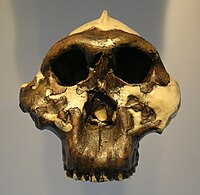
Photo from wikipedia
ABSTRACT Objective: The aim of this study was to evaluate the volumetric root resorption in maxillary incisors following clear aligner therapy (CAT) with low-intensity pulsed ultrasound (LIPUS), and compare the… Click to show full abstract
ABSTRACT Objective: The aim of this study was to evaluate the volumetric root resorption in maxillary incisors following clear aligner therapy (CAT) with low-intensity pulsed ultrasound (LIPUS), and compare the results to CAT alone. Material and Methods: This retrospective study evaluated pretreatment (T0) and post-treatment (T1) cone-beam computed tomography imaging of 42 adult patients. Twenty-one patients (14 females, 7 males, mean age= 38.1±12.96 years) were treated using CAT with LIPUS device, whereas the other twenty-one matching controls patients (15 females, 6 males, mean age= 35.6±11.7 years) were treated using CAT alone. Images were analyzed and a segmentation protocol was applied on the maxillary incisors. Each segmented tooth volume was exported as a surface mesh in the Visualization Toolkit (VTK) file format. The VTK files for all maxillary incisors were coded and corresponding teeth volumes from T0 and T1 were superimposed. Clipping the crown of each tooth was done, then measurements of root volumes and differences between groups were performed. Changes in root volumes were assessed (p<0.05). Results: Root loss was evident in all teeth in both groups, but was significantly increased in all maxillary incisors of the control group (p<0.001) and in upper left central incisor of LIPUS group (p=0.009). When both groups were compared, there was statistically significant minimal volumetric root loss in LIPUS group (3.50-7.32 mm3), when compared to control group (11.48-12.95 mm3) (p<0.05). Conclusion: LIPUS group showed less volumetric root resorption compared to control group during the studied treatment time using clear aligners.
Journal Title: Dental Press Journal of Orthodontics
Year Published: 2023
Link to full text (if available)
Share on Social Media: Sign Up to like & get
recommendations!